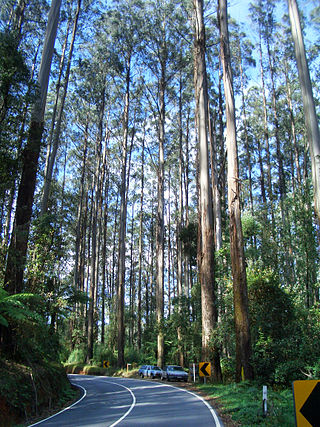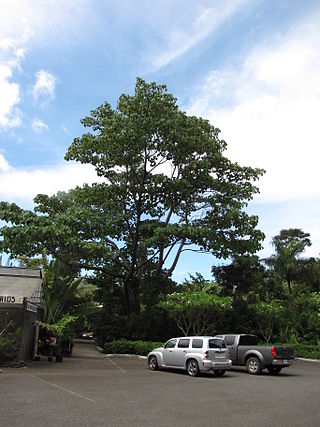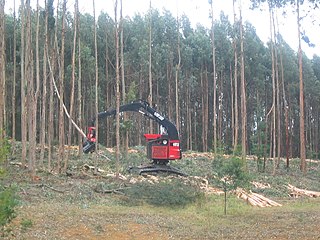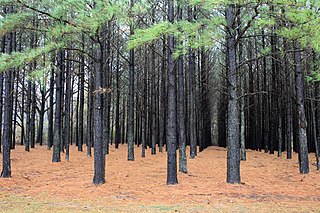
Mahogany is a straight-grained, reddish-brown timber of three tropical hardwood species of the genus Swietenia, indigenous to the Americas and part of the pantropical chinaberry family, Meliaceae. Mahogany is used commercially for a wide variety of goods, due to its coloring and durable nature. It is naturally found within the Americas, but has also been imported to plantations across Asia and Oceania. The mahogany trade may have begun as early as the 16th century and flourished in the 17th and 18th centuries. In certain countries, mahogany is considered an invasive species.

Eucalyptus is a genus of more than 700 species of flowering plants in the family Myrtaceae. Most species of Eucalyptus are trees, often mallees, and a few are shrubs. Along with several other genera in the tribe Eucalypteae, including Corymbia and Angophora, they are commonly known as eucalypts or "gum trees". Plants in the genus Eucalyptus have bark that is either smooth, fibrous, hard, or stringy, the leaves have oil glands, and the sepals and petals are fused to form a "cap" or operculum over the stamens. The fruit is a woody capsule commonly referred to as a "gumnut".

Reforestation is the practice of restoring previously existing forests and woodlands that have been destroyed or damaged. The prior forest destruction might have happened through deforestation, clearcutting or wildfires. Three important purposes of reforestation programs are for harvesting of wood, for climate change mitigation, and for ecosystem and habitat restoration purposes. One method of reforestation is to establish tree plantations, also called plantation forests. They cover about 131 million ha worldwide, which is 3% of the global forest area and 45% of the total area of planted forests.

Coppicing is the traditional method in woodland management of cutting down a tree to a stump, which in many species encourages new shoots to grow from the stump or roots, thus ultimately regrowing the tree. A forest or grove that has been subject to coppicing is called a copse or coppice, in which young tree stems are repeatedly cut down to near ground level. The resulting living stumps are called stools. New growth emerges, and after a number of years, the coppiced trees are harvested, and the cycle begins anew. Pollarding is a similar process carried out at a higher level on the tree in order to prevent grazing animals from eating new shoots. Daisugi, is a similar Japanese technique.

Eucalyptus regnans, known variously as mountain ash, giant ash or swamp gum, or stringy gum, is a species of very tall forest tree that is native to the Australia states of Tasmania and Victoria. It is a straight-trunked tree with smooth grey bark, but with a stocking of rough brown bark at the base, glossy green, lance-shaped to curved adult leaves, flower buds in groups of between nine and fifteen, white flowers, and cup-shaped or conical fruit. It is the tallest of all flowering plants; the tallest measured living specimen, named Centurion, stands 100 metres tall in Tasmania.

Ochroma pyramidale, commonly known as the balsa tree, is a large, fast-growing tree native to the Americas. It is the sole member of the genus Ochroma. The tree is famous for its wide usage in woodworking, due to its softness and its high strength compared to its low density. The name balsa is the Spanish word for "raft."

Pulpwood can be defined as timber that is ground and processed into a fibrous pulp. It is a versatile natural resource commonly used for paper-making but also made into low-grade wood and used for chips, energy, pellets, and engineered products.
Energy forestry is a form of forestry in which a fast-growing species of tree or woody shrub is grown specifically to provide biomass or biofuel for heating or power generation.
Forest integrated pest management or Forest IPM is the practice of monitoring and managing pest and environmental information with pest control methods to prevent pest damage to forests and forest habitats by the most economical means.

Eucalyptus grandis, commonly known as the flooded gum or rose gum, is a tall tree with smooth bark, rough at the base fibrous or flaky, grey to grey-brown. At maturity, it reaches 50 metres tall, though the largest specimens can exceed 80 metres tall. It is found on coastal areas and sub-coastal ranges from Newcastle in New South Wales northwards to west of Daintree in Queensland, mainly on flat land and lower slopes, where it is the dominant tree of wet forests and on the margins of rainforests.

The Sustainable Forestry Initiative (SFI) is a sustainability organization operating in the U.S. and Canada that works across four pillars: standards, conservation, community, and education. SFI was founded in 1994 by the American Forest & Paper Association (AF&PA). SFI is the world's largest single forest certification standard by area. SFI is headquartered in Ottawa and Washington, D.C.

Eucalyptus robusta, commonly known as swamp mahogany or swamp messmate, is a tree native to eastern Australia. Growing in swampy or waterlogged soils, it is up to 30 m (100 ft) high with thick spongy reddish-brown bark and dark green broad leaves, which help form a dense canopy. The white to cream flowers appear in autumn and winter. The leaves are commonly eaten by insects and are a food item for the koala. It is an important autumn-winter flowering species in eastern Australia and has been planted extensively in many countries around the world. Its timber is used for firewood and in general construction.
Rubberwood is a light-colored medium-density tropical hardwood obtained from the Pará rubber tree, usually from trees grown in rubber plantations. Rubberwood is commonly advertised as an "environmentally friendly" wood, as it makes use of plantation trees that have already served a useful function.
Proteak is a forestry company that cultivates teak trees on plantations located on reclaimed ranch lands in the dry tropical regions of Mexico and Latin America. Based out of Mexico City, Mexico, Proteak has satellite offices in Wimberley, Texas and Tepic, Mexico. At their manufacturing facilities, Proteak produces a range of teak products including: cutting boards, butcher blocks, decking, flooring and lumber.
Island Timberlands LP, a private timberlands business in British Columbia, Canada, was created in 2005 by the purchase of lands from Weyerhaeuser's coastal BC timber estate, which had originally been purchased in 1999 from MacMillan Bloedel. The private managed forest lands comprise approximately 254,000 hectares of forests, both mature and regenerating. The majority of timber harvested from these lands is shipped to overseas clients as unprocessed logs.

A genetically modified tree is a tree whose DNA has been modified using genetic engineering techniques. In most cases the aim is to introduce a novel trait to the plant which does not occur naturally within the species. Examples include resistance to certain pests, diseases, environmental conditions, and herbicide tolerance, or the alteration of lignin levels in order to reduce pulping costs.
The wood industry or timber industry is the industry concerned with forestry, logging, timber trade, and the production of primary forest products and wood products and secondary products like wood pulp for the pulp and paper industry. Some of the largest producers are also among the biggest owners of forest. The wood industry has historically been and continues to be an important sector in many economies.

The Southwest Iberian Mediterranean sclerophyllous and mixed forests is a Mediterranean forests, woodlands, and scrub ecoregion in southwestern Europe. It occupies the southwestern Iberian Peninsula, encompassing coastal lowlands and mountains in portions of Portugal and Spain.

A tree plantation, forest plantation, plantation forest, timber plantation or tree farm is a forest planted for high volume production of wood, usually by planting one type of tree as a monoculture forest. The term tree farm also is used to refer to tree nurseries and Christmas tree farms.













